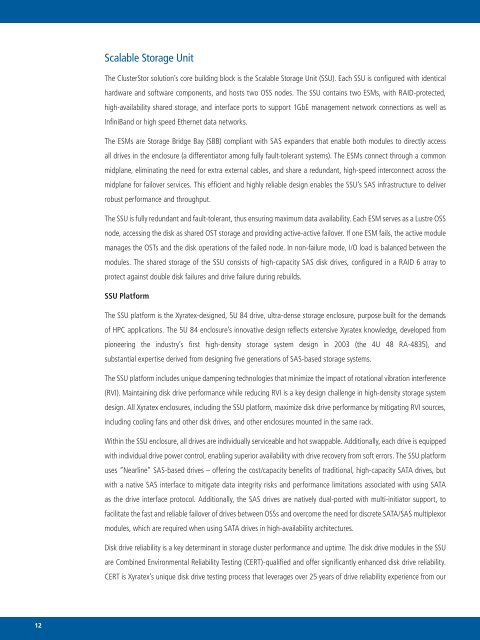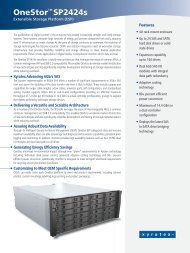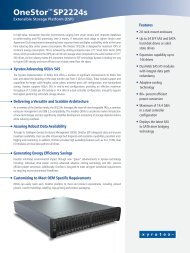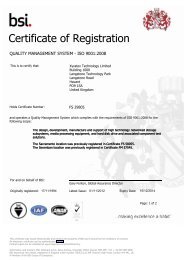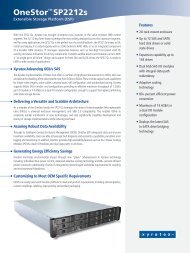Xyratex ClusterStorTM
Xyratex ClusterStorTM
Xyratex ClusterStorTM
You also want an ePaper? Increase the reach of your titles
YUMPU automatically turns print PDFs into web optimized ePapers that Google loves.
12<br />
Scalable Storage Unit<br />
The ClusterStor solution’s core building block is the Scalable Storage Unit (SSU). Each SSU is configured with identical<br />
hardware and software components, and hosts two OSS nodes. The SSU contains two ESMs, with RAID-protected,<br />
high-availability shared storage, and interface ports to support 1GbE management network connections as well as<br />
InfiniBand or high speed Ethernet data networks.<br />
The ESMs are Storage Bridge Bay (SBB) compliant with SAS expanders that enable both modules to directly access<br />
all drives in the enclosure (a differentiator among fully fault-tolerant systems). The ESMs connect through a common<br />
midplane, eliminating the need for extra external cables, and share a redundant, high-speed interconnect across the<br />
midplane for failover services. This efficient and highly reliable design enables the SSU’s SAS infrastructure to deliver<br />
robust performance and throughput.<br />
The SSU is fully redundant and fault-tolerant, thus ensuring maximum data availability. Each ESM serves as a Lustre OSS<br />
node, accessing the disk as shared OST storage and providing active-active failover. If one ESM fails, the active module<br />
manages the OSTs and the disk operations of the failed node. In non-failure mode, I/O load is balanced between the<br />
modules. The shared storage of the SSU consists of high-capacity SAS disk drives, configured in a RAID 6 array to<br />
protect against double disk failures and drive failure during rebuilds.<br />
SSU Platform<br />
The SSU platform is the <strong>Xyratex</strong>-designed, 5U 84 drive, ultra-dense storage enclosure, purpose built for the demands<br />
of HPC applications. The 5U 84 enclosure’s innovative design reflects extensive <strong>Xyratex</strong> knowledge, developed from<br />
pioneering the industry’s first high-density storage system design in 2003 (the 4U 48 RA-4835), and<br />
substantial expertise derived from designing five generations of SAS-based storage systems.<br />
The SSU platform includes unique dampening technologies that minimize the impact of rotational vibration interference<br />
(RVI). Maintaining disk drive performance while reducing RVI is a key design challenge in high-density storage system<br />
design. All <strong>Xyratex</strong> enclosures, including the SSU platform, maximize disk drive performance by mitigating RVI sources,<br />
including cooling fans and other disk drives, and other enclosures mounted in the same rack.<br />
Within the SSU enclosure, all drives are individually serviceable and hot swappable. Additionally, each drive is equipped<br />
with individual drive power control, enabling superior availability with drive recovery from soft errors. The SSU platform<br />
uses “Nearline” SAS-based drives – offering the cost/capacity benefits of traditional, high-capacity SATA drives, but<br />
with a native SAS interface to mitigate data integrity risks and performance limitations associated with using SATA<br />
as the drive interface protocol. Additionally, the SAS drives are natively dual-ported with multi-initiator support, to<br />
facilitate the fast and reliable failover of drives between OSSs and overcome the need for discrete SATA/SAS multiplexor<br />
modules, which are required when using SATA drives in high-availability architectures.<br />
Disk drive reliability is a key determinant in storage cluster performance and uptime. The disk drive modules in the SSU<br />
are Combined Environmental Reliability Testing (CERT)-qualified and offer significantly enhanced disk drive reliability.<br />
CERT is <strong>Xyratex</strong>’s unique disk drive testing process that leverages over 25 years of drive reliability experience from our


